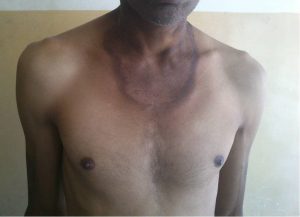2237
Very rare disease in the US.
Associated with dermatitis, diarrhea, dementia and, if untreated, death.
A potentially fatal nutritional disease with G.I., cutaneous, and neuropsychiatric manifestations.
Pellagra can cause a bright red tongue and changes in the digestive tract that lead to vomiting, constipation, or diarrhea.
The neurological symptoms of pellagra can include depression; apathy; headache; fatigue; loss of memory that can progress to aggressive, paranoid, and suicidal behaviors; and auditory and visual hallucinations.
Caused by severe malnutrition associated with vitamin B3 (niacin) deficiency and probably excessive intake of leucine found in corn and cereals.
Maybe caused by protein metabolism disorders as seen in carcinoid syndrome or Hartnup disease.
Pellagra dermatitis involves sun exposed in bilateral and a symmetrical pattern.
Diagnosis by a glove-like rash on the hands.
Associated with Casal’s necklace.

The combination of dermatitis, dementia, and diarrhea suggest the diagnosis, especially in the presence of poor nutritional intake.
May be associated with peripheral neuropathy.
Maybe seen in patients with eating disorders and those suffering from severe malnutrition due to neuropsychiatric disease.
As pellagra progresses, anorexia develops, and the affected individual eventually dies
Pellagra is uncommon in industrialized populations and is mostly limited to people living in poverty, such as refugees and displaced people who eat very limited diets low in niacin and protein.
The World Health Organization recommends treating pellagra with 300 mg/day nicotinamide in divided doses for 3-4 weeks along with a B-complex or yeast product to treat likely deficiencies in other B vitamins.
